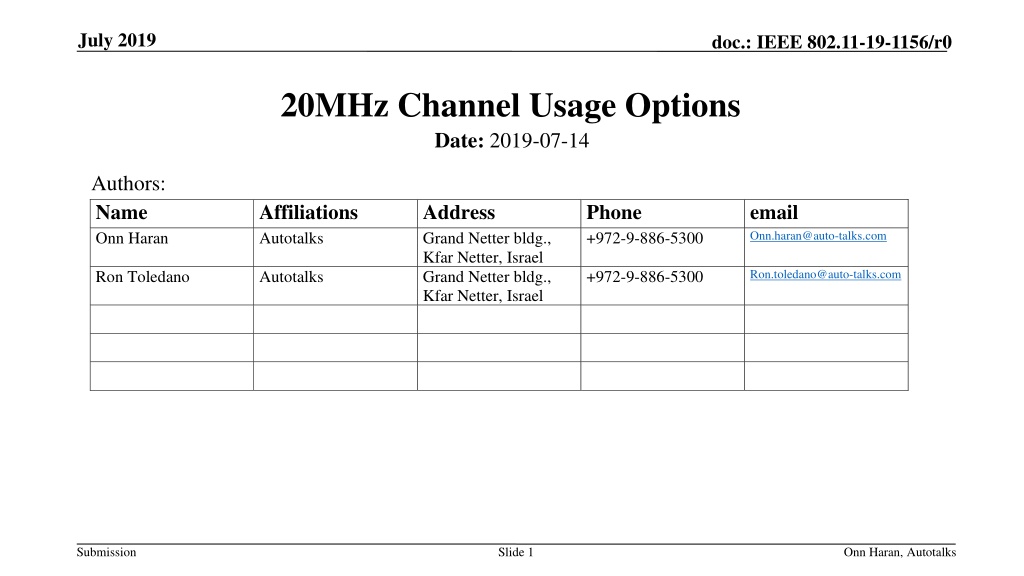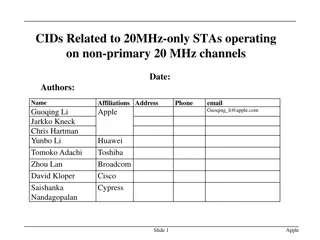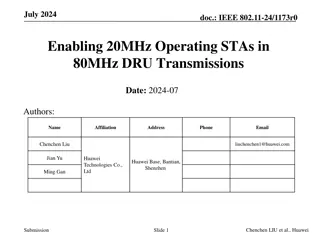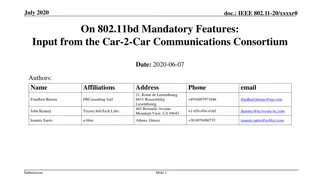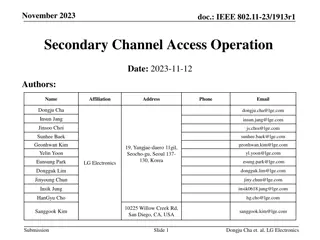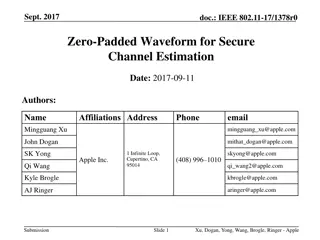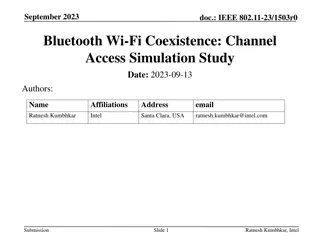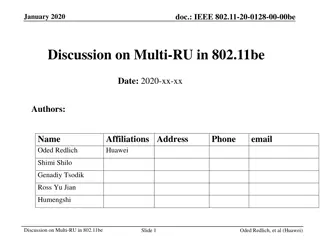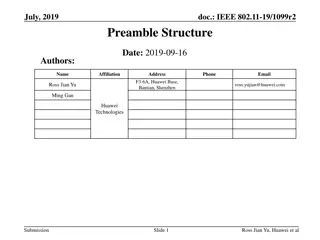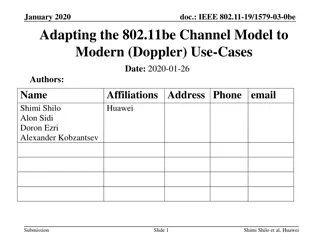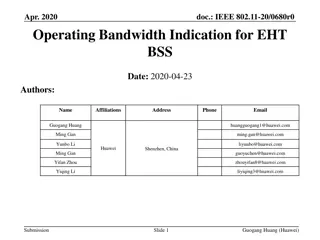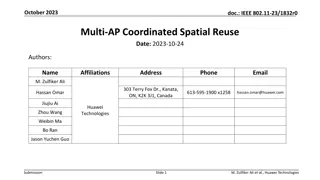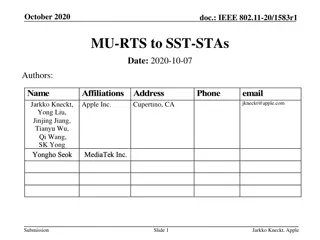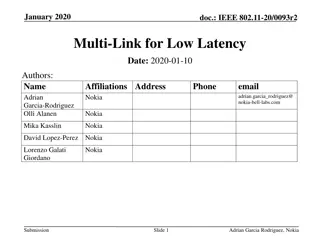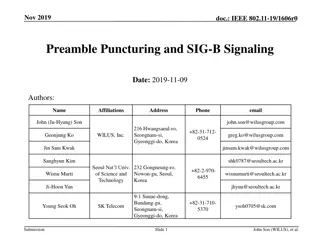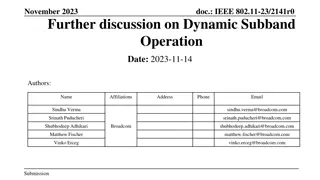IEEE 802.11-19-1156/r0: 20MHz Channel Usage Options
This document discusses the utilization of 20MHz channels in IEEE 802.11-19-1156/r0 standard, focusing on high-bandwidth use-cases such as cooperative perception. It addresses the impact of concurrent transmission in adjacent channels, the importance of predetermined sub-channels for efficient service utilization, and strategies to mitigate interference and ensure protection for both sub-channels.
Download Presentation

Please find below an Image/Link to download the presentation.
The content on the website is provided AS IS for your information and personal use only. It may not be sold, licensed, or shared on other websites without obtaining consent from the author. Download presentation by click this link. If you encounter any issues during the download, it is possible that the publisher has removed the file from their server.
E N D
Presentation Transcript
July 2019 doc.: IEEE 802.11-19-1156/r0 20MHz Channel Usage Options Date: 2019-07-14 Authors: Name Onn Haran Affiliations Autotalks Address Grand Netter bldg., Kfar Netter, Israel Grand Netter bldg., Kfar Netter, Israel Phone +972-9-886-5300 email Onn.haran@auto-talks.com Ron.toledano@auto-talks.com Ron Toledano Autotalks +972-9-886-5300 Submission Slide 1 Onn Haran, Autotalks
July 2019 doc.: IEEE 802.11-19-1156/r0 Assumptions 1. 20MHz channel can enable high-bandwidth use-cases, such as cooperative perception 2. Both 10MHz sub-channels are carrying safety data Same high level of protection is needed for both Having said that, the channels composing the 20MHz channels, are rarely used today 3. Concurrent transmission in two adjacent channels create mutual interference, shortening communication range of both channels Submission Slide 2 Onn Haran, Autotalks
July 2019 doc.: IEEE 802.11-19-1156/r0 Stating the obvious: Service should use a single predetermined sub-channel Service breaks if both 10MHz sub-channels are used Busy (st A) 10MHz TX (st B) Busy Transmission of station A isn t received by station B and vice-versa. Station B can t determine which station transmits while reception is ongoing. A common service to station A and B would be broken if station B would use different sub-channel than station A Submission Slide 3 Onn Haran, Autotalks
July 2019 doc.: IEEE 802.11-19-1156/r0 Options for 20MHz Channel Usage No usage of 10MHz sub-channels Predetermined 10MHz sub-channel may be used Busy Busy 20MHz TX 10MHz TX Busy Busy Predetermined 20MHz channel transmission is deferred when either of the 10MHz sub-channels is busy Transmission uses predetermined 10MHz sub- channel when other sub-channel is busy Receiving only 20MHz channel Receiving either 20MHz or predetermined 10MHz sub-channel Submission Slide 4 Onn Haran, Autotalks
July 2019 doc.: IEEE 802.11-19-1156/r0 Adjacent Channel Interference No usage of 10MHz sub-channels Predetermined 10MHz sub-channel may be used Busy Busy 20MHz TX 10MHz TX No adjacent channel interference Strong adjacent channel interference Submission Slide 5 Onn Haran, Autotalks
July 2019 doc.: IEEE 802.11-19-1156/r0 Protection of Second Sub-Channel No usage of 10MHz sub-channels Predetermined 10MHz sub-channel may be used Busy Busy Busy 20MHz TX 20MHz TX 10MHz TX Busy RX NAVs of both sub-channels are detected and respected NAV should be respected while sub- channel is received NAV is ignored while sub- channel is transmitting, settling on lower protection of guard-interval correlation Submission Slide 6 Onn Haran, Autotalks
July 2019 doc.: IEEE 802.11-19-1156/r0 Link Utilization No usage of 10MHz sub-channels Predetermined 10MHz sub-channel may be used Sparsely used sub-channels: high utilization for both Busy Busy 20MHz TX 20MHz TX 20MHz TX 10MHz TX Heavily used other sub-channel: advantage to 10MHz channel usage Busy Busy Busy Busy 20MHz TX 20MHz TX 20MHz TX 10MHz TX Heavily used predetermined sub-channel: low utilization for both 20MHz TX 20MHz TX Busy Busy Busy Busy Submission Slide 7 Onn Haran, Autotalks
July 2019 doc.: IEEE 802.11-19-1156/r0 Implementation Complexity No usage of 10MHz sub-channels Predetermined 10MHz sub-channel may be used RX/TX front end L-STF detector L-STF detector 10/20MHz receiver 20MHz receiver RX/TX front end 10MHz NAV receiver of either sub-channel RX front end L-STF detector 10MHz NAV receiver L-STF detector No concurrent reception Single receiver, toggling between 20MHz reception and NAV reception in either 10MHz sub-channels Single radio (always tuned to 20MHz channel) Concurrent reception (for NAV during sub-channel reception) NAV receiver is almost as complicated as full receiver Dual radio is needed to maintain receiver sensitivity and adjacent channel rejection Simplified solution would have been possible with compromised protection of other sub-channel Submission Slide 8 Onn Haran, Autotalks
July 2019 doc.: IEEE 802.11-19-1156/r0 Comparison Summary No usage of 10MHz sub-channels 20MHz transmission when both sub-channels are idle Good. Both are protected 10MHz sub-channels may be used Using predetermined 10MHz sub-channel when other sub-channel is busy Mostly good. The other sub-channel is less protected after 10MHz transmission Mutual interference to other sub-channel Double. Dual receiver and dual radio path Transmission operation Protection of 10MHz sub-channels Adjacent channel Implementation complexity / cost Link utilization No interference from other sub-channel Medium. Single receiver and single radio path Medium-low. Not coping with heavily used sub-channels Medium. Can cope with heavily used other sub-channel. Can t cope with busy predetermined sub-channel Summary Using 10MHz sub-channel doubles complexity and creates adjacent channel interference for better coping with heavy load in non predetermined sub-channel Submission Slide 9 Onn Haran, Autotalks
Month Year doc.: IEEE 802.11-19-1156/r0 Not to Decide is to Decide In theory, both options can be allowed In practice, implementation is different Implementation would have to support the more complicated option: using 10MHz sub- channel Submission Slide 10 Ron Toledano, Autotalks
July 2019 doc.: IEEE 802.11-19-1156/r0 Straw Poll #1 Do you agree to add the following text into Section 3 of SFD? During receive, 802.11bd 20MHz shall detect both 10MHz sub-channels NAV Y: N: A: Submission Slide 11 Onn Haran, Autotalks
July 2019 doc.: IEEE 802.11-19-1156/r0 Straw Poll #2 Which of 20MHz operation methods is preferred? 1. No usage of 10MHz sub-channels: 2. Predetermined 10MHz sub-channel may be used: 3. None of the above: Abstain: Submission Slide 12 Onn Haran, Autotalks
July 2019 doc.: IEEE 802.11-19-1156/r0 Straw Poll #3a Do you agree to add the following text into Section 3 of SFD? 802.11bd 20MHz channel shall not use 10MHz sub-channels Y: N: A: Submission Slide 13 Onn Haran, Autotalks
July 2019 doc.: IEEE 802.11-19-1156/r0 Straw Poll #3b Do you agree to add the following text into Section 3 of SFD? 802.11bd 20MHz channel may use predetermined 10MHz sub-channel Y: N: A: Submission Slide 14 Onn Haran, Autotalks
